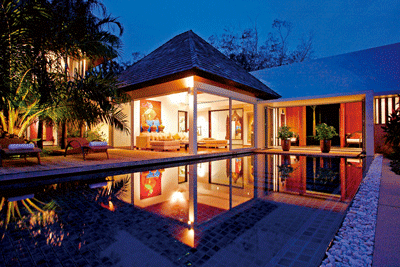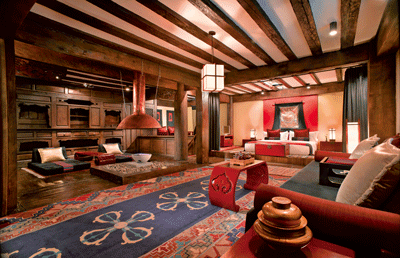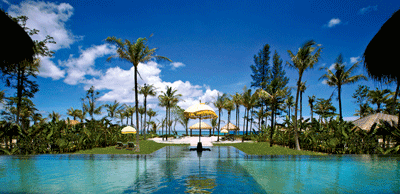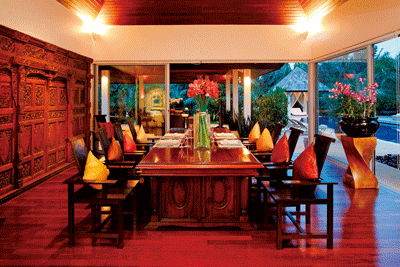How would you like to pay a fraction of what it costs to buy a vacation home and have access to tens or even hundreds of luxury residences scattered around the world in scenic and convenient locations? If that sounds about right, then maybe you should consider membership of a residence club – a concept which is well-established in the US, but which only began to take off in Asia in the last few years.
Residence clubs, also known as destination clubs, are high-end resorts where members pay an upfront joining fee – usually in the US$150,000 range – as well as annual fees. In return, they get access to a wide portfolio of luxury holiday homes around the world, which they can use for a certain number of days a year – typically around one to two weeks, depending on the membership type.
The idea behind them is that holiday-goers are likely to be willing to pay a membership fee and be saved the hassle of buying and maintaining their own holiday home. They will also pay a fraction of what it costs to buy just one residence – which they end up typically only using for two or three weeks a year anyway – and have access to holiday homes in different places where they can explore and discover each time they go on vacation.
Take for example Stephen and Barbara Anthony of Wellfleet, Massachusetts, who joined The Ritz-Carlton Club in 2009. His membership consists of a deeded, part-interest in a multimillion-dollar, two-bedroom holiday home in Kapalua Bay, Maui, which they can use for 35 days a year, plus they have access to the club’s other holiday homes around the world from Lake Tahoe in California, to Moscow and Sharm El Sheikh in Egypt.
“We are now on our second visit since we acquired it. It’s just been everything we could have hoped for and more,” says Stephen Anthony.
“Something we thought about a lot was that to come to Maui from the East Coast, you have to spend about 12 to 13 hours on an airplane, but after you are here about two days you say to yourself ‘wow it was worth it!’. And if this was the end of my vacation and I had to go home tomorrow, I still think it was worth it. It’s just that nice a place. We have always said Maui is paradise, but we feel that this place is paradise plus.
“It was very important to us to have a residence with enough room for our family, so that we can all be together. They love it here and they know that one day this will all be theirs. When we are no longer around, they know they will own it because we have full ownership of our time. We can will it to them and they will take on the responsibilities of ownership – which are nil in a place like this,” he adds.
Mike Balfour, chairman and co-founder of The Hideaways Club, a UK-based residence club which only opened offices in Asia in February, says: “The reality is that there is an awful lot of money tied up in second homes which tend to give owners enormous hassle. They are full of problems. People can have trouble finding the right gardeners or the boiler is not working and, at the end of that, they spend only three or four weeks in their second homes. [Residence club members] are able to not only invest considerably less money than what they would pay to buy one home, but instead they get to use hundreds of different properties all around the world.”

Not time shares
Unlike time shares, which are only contracts specifying a right to use a property on certain weeks, some residence club memberships consist of actual deeded property interest. For example, one Asia-focused club is Banyan Tree Private Collection, which sells members a non-expiring membership. This not only grants members the right to use the club’s residences – 60-plus villas – in diverse locations such as Phuket, Ringha, the Seychelles or Tuscany, but is also backed by the club’s assets in the form of the property deeds. Currently, the collection has just under 200 members, mostly based in Asia.

Residence clubs also tend to be more flexible than time-shares, says Marina Kleiman, managing director, Banyan Tree Private Collection. This is because members can book their holiday for any time of the year, unlike time shares which require share owners to navigate a tricky barter system if they want to use their holiday home at a time in the year outside of the period for which they initially bought the share.
On the other hand, UK-based The Hideaways Club takes a slightly different approach. Taking a leaf from the financial services sector, its members invest in shares of a property investment fund which collectively owns the club’s properties. The company will close the fund when it has 600 full members and 100 villas, which it expects will happen within three years’ time.
Balfour says that membership up-take in Asia has been particularly fast and he expects members from the region to make up for 30 percent of the total when the fund closes. Currently, its membership is approaching 200 and it owns 27 properties spread across Europe and Africa, and in Mauritius and Malaysian Borneo.

Just like its mutual fund counterpart, the price of this share can go down as well as up and it can be sold to realise any capital gains or losses. Besides the security of investment afforded by ownership in real assets, and because the fund invests in properties in the four corners of the world, it is hedged against sharp falls in the price of property of any one given country. The value of a property in one country may be going down at the same time as other properties are appreciating, he says.
Then there is the model adopted by the typical American destination club, such as Denver, Colorado-based Exclusive Resorts. With more than 3,000 members and a real estate portfolio of more than US$1 billion in 400 multimillion-dollar luxury residences, the resort sells 30-year term memberships that bestow on members only the right to use a certain number of days at the company’s residences, dotted around the Americas and Europe, without any ownership rights. The resort’s senior vice-president Jeff Hartman says the advantage of that model is simplicity and certainty, which means that members, when they do eventually exit the club, don’t have to face the complexity of a niche secondary market (luxury residence club memberships) or be subjected to its vagaries.
Price advantage
The main advantage of joining a residence club is supposedly the cost savings and return on investment. Take, for example, The Hideaways Club, which offers three types of membership. The entry-level membership is an associate, which carries with it a one-off joining fee of £127,500 (US$ 199,358). Associate members also have to pay annual dues of £7,000 (US$10,940), which cover everything from property taxes and utility bills to other costs such as concierge and gardening. For that, associate members get 60 usage points a year, which translates to roughly around two to three weeks of stay at any of the club’s villas, depending on whether they are making the bookings during peak seasons.

While a quarter of a million pounds in joining fees may sound steep on the surface, that is a fraction of the cost of purchasing a multimillion dollar vacation home that people may use only for a few weeks a year, Balfour says. Moreover, the annual dues represent a 60 percent discount on the equivalent rent that vacationers would have to pay if they booked similar properties at market rates. On top of that, he says that the club portfolio has consistently appreciated by between 5 percent and 6 percent since it started three years ago. As memberships can be resold, the rental costs savings combined with the appreciation in the fund shares produces an equivalent total return to members of around 14 percent per annum, he claims.
Meanwhile, Banyan Tree Private Collection charges a US$150,000 membership fee and annual fees of US$3,000 for its basic plan. This gives a member a week’s stay at any of the villas in the collection. Kleiman estimates that most members break even with how much they have invested in the club within eight years, based on the fact that it costs up to US$3,000 a night to stay in the collection’s top villas.
Finally, Exclusive Resorts offers membership plans ranging from the most basic – which costs US$160,000 to join plus annual fees of US$9,995 and offers members 10 days’ stay a year, to more elaborate affairs costing US$500,000 up front and US$59,700 a year for 60 days of use annually.
Top-notch stay
Ragatz Associates, a US-based specialty resort real estate consultancy, estimates that the average residence in seven US destination clubs has a reported value of US$2.6 million, with an average size of 195sqm. This also means that properties have at least two bedrooms and are fitted with the usual high-end entertainment equipment, including large LCD televisions, Wi-Fi broadband internet and a top-of-the-range, fully equipped kitchen.
On top of that, clubs also have a dedicated concierge service, both to help members plan their vacation and to arrange airport transfers and to advise and arrange activities from golf, wine tasting, yoga, skiing and spa treatments to tickets to local events – or even to hire a personal chef or do the grocery shopping. Finally, all the other hassles associated with holiday ownership are non-existent. The club takes care of routine maintenance, from mowing the lawn and shovelling sidewalks to making sure that all equipment, such as central water heaters, are in working order.
There are downsides, of course. The most obvious, compared to owning your own holiday home, is that you cannot redecorate or even hang your own photos up on the wall. Another is that you may not get what you want all the time, especially during the peak holiday seasons, such as the months when European schools are closed for the summer vacation.
For residence clubs, however, this is somewhat mitigated by their exclusivity. The Hideaways Club, for example, maintains a strict ratio of six members for every villa it owns. When members are not using them, they are not rented out to the public. In practice, this translates to the average property being occupied by any given member for only 25 weeks a year.
Similarly, Banyan Tree Private Collection maintains its membership levels so that on average the villas are in use only 35 weeks every year, out a total of 52, so the chances of the preferred villa being available is high.
“In fact, if your goal is to go to Phuket every Christmas, we actually do not recommend you to join. If you want to do that, you can pay a fixed rate per night and you can get any villa you want in Phuket. With our membership, you may not be satisfied because we cannot ensure that you’ll get Phuket every year. These are programmes for people who want to travel the world,” Banyan Tree Private Collection’s Kleiman says.
It pays to shop around
When shopping for a residence club membership, it pays to read the fine print. Different clubs offer subtly different terms which could have a significant impact on how you spend your vacation, as well as how much money you get back if you decide to exit the club.
Banyan Tree Private Collection members get the full market value of their membership back when they choose to leave the club. On the other hand, shareholders who invest in The Hideaways Club will have to pay what is equivalent to a 20 percent fee should they decide to part ways with their shares in the property investment fund. Finally, Exclusive Resorts gives its members 75 percent of the membership fee back when they decide to leave.
Different clubs also have different policies on what members can do with any leftover vacation days. Banyan Tree Private Collection allows its members to extend any unused stay at villas for one year. At the other end is Exclusive Resorts, which requires members to use up all their annual resort stays within the year or lose them. The resort does, however, allow members to book two holiday homes simultaneously, to facilitate large family gatherings. In between the two is The Hideaways Club, which allows members to carry forward a maximum of 30 usage points from one year to the next.
Exclusive Resort’s Hartman says that, when considering which club to join, prospective holiday-goers should think about how they want to spend their vacations and whether those needs would be met by the different memberships. “They should compare the way they like to travel and places they like to go, with the specific types of accommodations and destinations offered by the club. For instance, if they like to travel in bigger groups and to beach vacations, they’ll want to understand how big the club’s residences are, how many bedrooms each villa has, and at what type of beaches,” he says.
From a business standpoint, they should also look at the club management team’s experience, how long they have been in business, the number of vacations they have delivered, how many properties they offer and, if possible, talk to current members about their experiences. Finally, he says that members who do join a club should make use of the club’s concierge service not only to understand how to book their holiday homes, but also to discover new destinations.
“Concierges, such as our resort’s member services managers, would in many cases be able to counsel their members on vacations they may not have considered, but that they would almost be certain to enjoy on the basis of feedback from other members,” he said.








